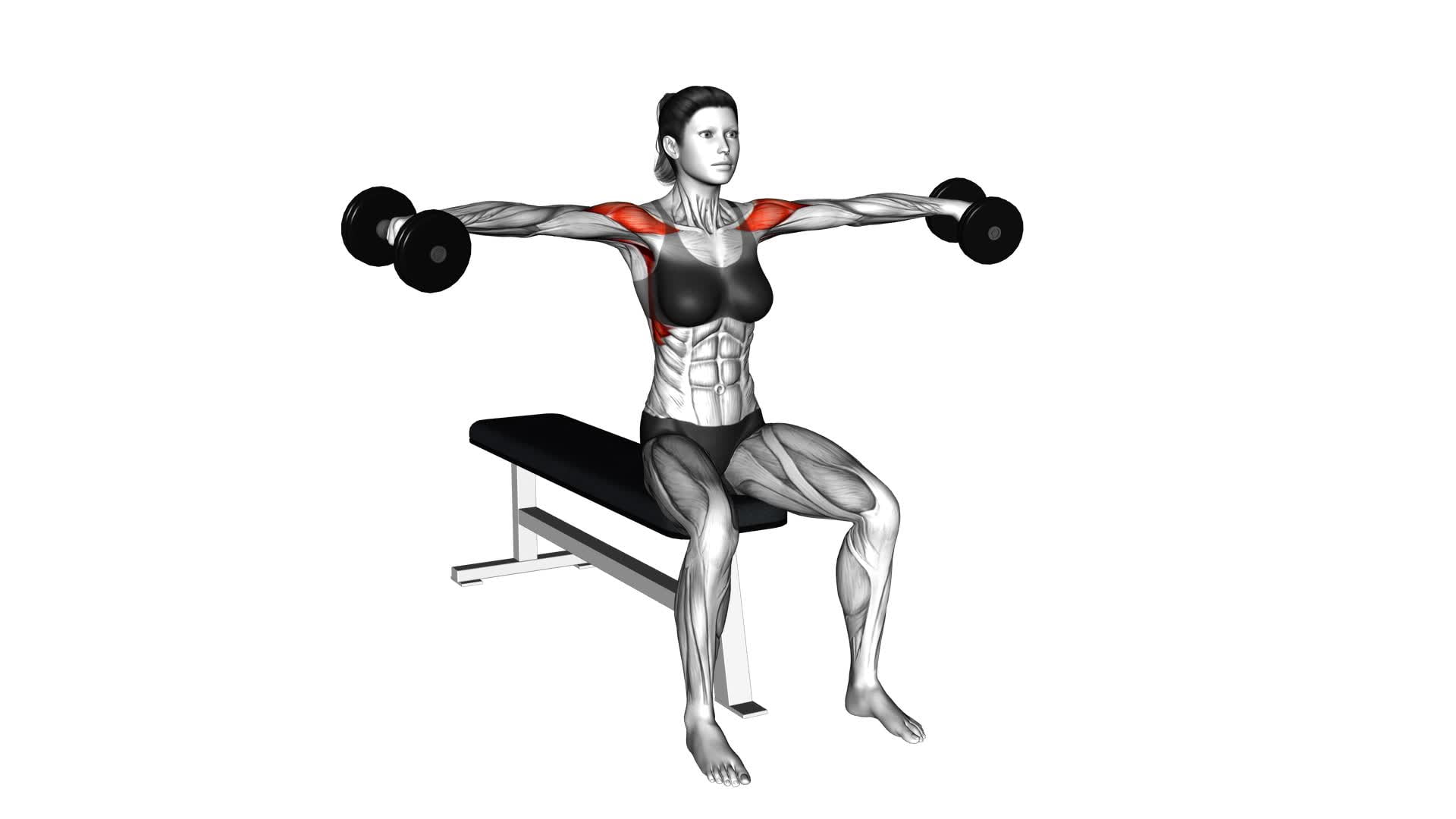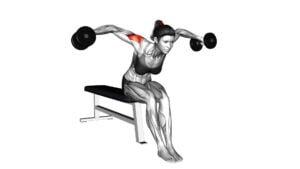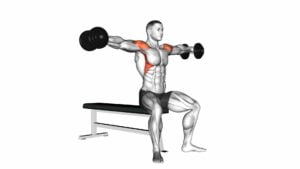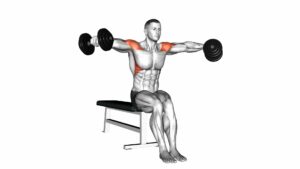Dumbbell Seated Lateral Raise (female) – Video Exercise Guide & Tips

Are you looking to tone and strengthen your shoulders? Look no further than the dumbbell seated lateral raise. This exercise targets the deltoid muscles, giving you sculpted and defined shoulders.
Watch This Exercise Video
In this video exercise guide, we'll show you the proper form and execution, as well as common mistakes to avoid. With our expert tips and variations, you'll be able to progress and challenge yourself with this effective shoulder exercise.
Let's get started!
Key Takeaways
- Proper equipment and set-up, including dumbbells and a stable chair or bench, are essential for performing Dumbbell Seated Lateral Raise effectively.
- Selecting the correct dumbbell weight based on your strength and fitness level is crucial for maximizing the benefits of the exercise.
- The step-by-step execution of the Dumbbell Seated Lateral Raise involves sitting upright, holding dumbbells with palms facing inward, raising the dumbbells to the side until arms are parallel to the floor, and maintaining proper form throughout.
- To avoid common mistakes, such as locking out the elbows or using excessive swinging or jerking motions, it is important to focus on controlled movements and maintain a neutral spine and upright posture.
Proper Equipment and Set-Up
To properly execute the Dumbbell Seated Lateral Raise exercise, you'll need a set of dumbbells and a stable chair or bench. When it comes to equipment options, it's essential to choose dumbbells that suit your strength and fitness level. Opt for weights that allow you to perform the exercise with proper form, but still provide enough resistance to challenge your muscles.
The benefits of proper set-up are numerous. Using a stable chair or bench ensures that you have a secure and balanced base to perform the exercise. This stability allows you to focus solely on the movement and engage the targeted muscles effectively. Additionally, the use of dumbbells allows for a greater range of motion compared to using machines, promoting better muscle activation and development.
Now that you understand the importance of equipment and set-up, let's move on to the next crucial step: selecting the correct dumbbells for the exercise.
Correct Dumbbell Selection
When selecting the correct dumbbells for the Dumbbell Seated Lateral Raise exercise, consider your strength and fitness level to ensure proper form and muscle engagement. Weight selection plays a crucial role in maximizing the benefits of this exercise. Choosing weights that are too heavy can compromise your form and lead to injury, while selecting weights that are too light may not provide enough resistance to effectively target your shoulder muscles.
To determine the appropriate weight, start with a conservative choice that you can comfortably lift for 8-12 repetitions. The last few reps should feel challenging but manageable, allowing you to maintain proper form throughout the exercise. If you find that you can easily perform more than 12 repetitions with the selected weight, it's time to increase the weight for a greater challenge.
Maintaining proper form is essential in the Dumbbell Seated Lateral Raise exercise. Sit upright on a bench with your feet flat on the floor, holding a dumbbell in each hand. Keep your abs engaged, shoulders relaxed, and elbows slightly bent throughout the movement. Raise your arms out to the sides until they're parallel to the floor, then slowly lower them back down to starting position. Avoid swinging your body or using momentum to lift the weights, as this can diminish the effectiveness of the exercise and put unnecessary strain on your muscles and joints.
Step-by-Step Execution
To perform the Dumbbell Seated Lateral Raise exercise, follow these steps:
- Sit upright on a bench with your feet flat on the floor.
- Hold a dumbbell in each hand, palms facing inward towards your body.
- Start with your arms by your sides, elbows slightly bent. This is your starting position.
Keeping a slight bend in your elbows, perform the following movements:
- Exhale as you raise both dumbbells to the side until your arms are parallel to the floor.
- Your elbows should be at shoulder height and your palms should be facing down.
- Hold the contracted position for a brief pause as you squeeze your shoulder blades together.
Inhale as you perform the following movements:
- Slowly lower the dumbbells back to the starting position, controlling the movement.
- Repeat for the recommended number of repetitions.
The dumbbell seated lateral raise targets the lateral deltoids, the muscles on the sides of your shoulders. This exercise helps to improve shoulder stability and posture, as well as enhance upper body strength. By isolating the shoulder muscles, you can effectively build definition and shape in your shoulders.
Remember to choose a weight that challenges you but allows you to maintain proper form throughout the movement. As always, consult with a fitness professional before starting any new exercise program.
Common Mistakes to Avoid
One common mistake to avoid when performing the Dumbbell Seated Lateral Raise is allowing your elbows to lock out at the top of the movement. Locking out your elbows can put unnecessary strain on the joints and increase the risk of injury. To maintain proper form, keep a slight bend in your elbows throughout the exercise. This will help to engage the targeted muscles more effectively and ensure a safer workout.
Another common mistake is using too much weight. It's important to choose a weight that allows you to complete the exercise with proper form and without excessive swinging or jerking motions. If you find yourself using momentum to lift the dumbbells, it's a sign that the weight is too heavy. Reduce the weight and focus on controlled movements to maximize the effectiveness of the exercise.
Lastly, avoid leaning forward or backward during the exercise. Maintaining a neutral spine and upright posture is crucial for targeting the lateral deltoids properly. Leaning can shift the focus to other muscles and reduce the effectiveness of the exercise.
Tips for Progression and Variations
To progress and vary your Dumbbell Seated Lateral Raise workout, you can incorporate different weights, rep ranges, and variations of the exercise. When it comes to progression techniques, gradually increasing the weight you use is key. Start with a weight that challenges you but allows you to maintain proper form. As you get stronger, gradually increase the weight to continue challenging your muscles.
Another way to progress is by increasing the number of repetitions or sets you perform. This can help increase muscular endurance and overall strength.
In addition to progression techniques, there are advanced variations of the Dumbbell Seated Lateral Raise that you can try. One variation is the Standing Lateral Raise, where you perform the exercise while standing instead of seated. This engages your core and stabilizer muscles to a greater extent.
Another variation is the Arnold Press, where you rotate your arms as you raise the dumbbells, targeting different parts of the shoulder muscles. You can also try performing the exercise with resistance bands instead of dumbbells, which adds an extra challenge to your workout.
Incorporating different weights, rep ranges, and variations into your Dumbbell Seated Lateral Raise routine will help keep your workouts exciting and challenging. Remember to always listen to your body, start with proper form, and gradually progress to avoid injury.
Frequently Asked Questions
How Many Repetitions Should I Do for the Dumbbell Seated Lateral Raise Exercise?
To properly execute the dumbbell seated lateral raise exercise, you should start by sitting upright with a dumbbell in each hand, palms facing down.
Raise your arms out to the sides, keeping a slight bend in your elbows, until they're parallel to the floor.
Slowly lower them back down and repeat.
Avoid swinging your body or using momentum to lift the weights.
Aim for 8-12 repetitions to target your shoulder muscles effectively.
Can I Perform the Dumbbell Seated Lateral Raise Exercise Without a Bench?
Yes, you can perform the dumbbell seated lateral raise exercise without a bench. However, using a bench can provide additional benefits. It helps stabilize your body and maintain proper form, reducing the risk of injury.
If you don't have a bench, you can try alternative exercises like standing lateral raises or using a stability ball as a substitute. Remember to start with lighter weights and gradually increase as you build strength.
Is It Necessary to Warm up Before Performing the Dumbbell Seated Lateral Raise Exercise?
It is necessary to warm up before performing the dumbbell seated lateral raise exercise. Incorporating warm up exercises before strength training has several benefits.
- It helps increase blood flow to the muscles.
- It improves flexibility.
- It reduces the risk of injury.
Common mistakes to avoid during this exercise include:
- Using too much weight.
- Swinging the dumbbells.
- Not maintaining proper form.
Remember to start with a light warm up and gradually increase the intensity before starting the exercise.
What Muscles Does the Dumbbell Seated Lateral Raise Exercise Target?
The dumbbell seated lateral raise exercise targets the deltoid muscles in your shoulders. This exercise is great for women because it helps to strengthen and tone the upper body, giving you sculpted and defined shoulders.
It also improves posture and stability, which can be especially beneficial for women who may experience muscle imbalances or postural issues.
Incorporating the dumbbell seated lateral raise into your workout routine can help you achieve a strong and confident upper body.
Can I Modify the Dumbbell Seated Lateral Raise Exercise to Make It More Challenging?
To modify the dumbbell seated lateral raise exercise and increase its difficulty, there are a few options you can try.
One way is to increase the weight of the dumbbells you're using. This will challenge your muscles more and help you progress.
Another option is to slow down the movement and focus on controlling the weight throughout the exercise. This will engage your muscles more effectively.
Remember to always listen to your body and adjust accordingly.
Conclusion
In conclusion, the dumbbell seated lateral raise is an effective exercise for strengthening and toning the shoulders.
By following the proper equipment set-up, selecting the correct dumbbell weight, and executing the exercise with proper form, you can avoid common mistakes and achieve optimal results.
Remember to gradually increase the weight and try variations for continued progress.
Stay consistent and dedicated to your fitness routine to see improvements in your shoulder strength and appearance.

Author
Years ago, the spark of my life’s passion ignited in my mind the moment I stepped into the local gym for the first time. The inaugural bead of perspiration, the initial endeavor, the very first surge of endorphins, and a sense of pride that washed over me post-workout marked the beginning of my deep-seated interest in strength sports, fitness, and sports nutrition. This very curiosity blossomed rapidly into a profound fascination, propelling me to earn a Master’s degree in Physical Education from the Academy of Physical Education in Krakow, followed by a Sports Manager diploma from the Jagiellonian University. My journey of growth led me to gain more specialized qualifications, such as being a certified personal trainer with a focus on sports dietetics, a lifeguard, and an instructor for wellness and corrective gymnastics. Theoretical knowledge paired seamlessly with practical experience, reinforcing my belief that the transformation of individuals under my guidance was also a reflection of my personal growth. This belief holds true even today. Each day, I strive to push the boundaries and explore new realms. These realms gently elevate me to greater heights. The unique combination of passion for my field and the continuous quest for growth fuels my drive to break new ground.



